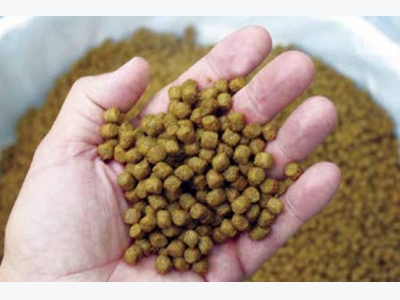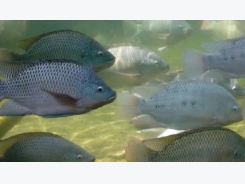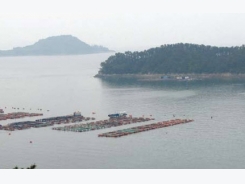Feed Efficiency Indicators for Responsible Aquaculture

Environmentally responsible, profitable aquaculture has its foundation in efficient resource use. Feed usually is the most costly item in aquaculture production. Fishmeal for aquaculture feeds is particularly expensive, and its sup-ply from the oceans is limited. Some environmentalists are concerned about the growing amount of fishmeal used by the aquaculture industry, especially in the culture of species that need a high percentage of fishmeal in their diets. Moreover, a great dependence on fishmeal could lead to a future limit on the expansion of aquaculture.
Feed Conversion Ratio
Nearly all aquaculture producers use feed conversion ra-tios (FCRs) as an index of feed use efficiency. FCR is determined by dividing the total feed use in a production unit or entire aquaculture facility by the net production of the culture species.
FCRs vary with several factors, including species, feed type and quality, production system, feeding tech-nique, and water quality conditions. Warmwater fish and shrimp farms typically achieve FCR values of 1.5-2.5, and for general purposes, FCR often is assumed to be 2.0.
Although FCRs are an excellent measure of feed use and economic efficiency, they can be misleading ecologi-cal indicators. For example, attainment of a 1.0 FCR does not imply that no wastes resulted from feeding.
Feeds typically contain about 90% dry matter and 10% water, while live fish and shrimp usually contain around 25% dry matter and 75% water. An FCR of 1.0 indicates that 1 kg of feed produced 1 kg fish or shrimp, but dis-counting moisture, 0.9 kg dry matter in feed produced only 0.25 kg dry matter in fish or shrimp. The dry matter FCR is 0.90/0.25, or only 3.6.
Summary:
While feed conversion ratios are often used as indexes of feed use efficiency, they can be misleading as eco-logical indicators. Indexes such as protein conversion ratios, protein efficiency, and fishmeal conversion can also be useful in evaluating the efficient use of protein and fishmeal in aquaculture.
Put another way, the production of 1 kg live biomass resulted in 0.65 kg waste (0.90 kg dry matter in feed - 0.25 kg dry matter in biomass). The recovery of dry matter feed nutrients in harvested biomass was 27.8% at an FCR of 1.0. As feed-conversion ratios increase, the quantity of waste per kilogram of production increases, and the per-centage of recovered feed nutrients in the harvested bio-mass decreases (Table 1).
Protein, Fishmeal Use
Protein, especially protein from fishmeal, is the most expensive component of aquaculture feeds. It also is the source of nitrogen in feeds and feeding wastes. There are possible economic and environmental benefits to feeds that contain no more protein and fishmeal than neces-sary. Several indexes can be useful in evaluating the effi-cient use of protein and fishmeal in aquaculture.
Protein Conversion Ratio
The protein conversion ratio (PCR) is the ratio of feed protein to net harvest biomass. It is calculated by multi-plying FCR by the proportion of crude protein in feed as shown below:

The PCR for a feed conversion ratio of 2.0 using a 35% crude protein feed is 0.7. For the same feed protein con-tent, PCR declines in direct proportion to declining FCR (Table 1).
Protein Efficiency
Protein efficiency (P.E.) is estimated by multiplying FCR by the ratio of crude protein percentage in feed to that in the culture species as shown below:

Protein efficiency is an estimate of the ratio of feed protein applied to protein contained in the net harvest biomass of the culture species. Live shrimp typically contain about 19.5% crude protein, while tilapia usually have a crude protein concentration of 14%. The P.E. for a shrimp farm where FCR is 2.0 and feed contains 35% crude protein is 2.0 (35%/19.5%) = 3.63. Tilapia feeds often have about 30% crude protein, so for an FCR of 2.0, P.E. is 4.29 for tilapia.
P.E. obviously decreases with lower feed protein lev-els and larger percentages of whole-body protein in cul-ture animals. Nevertheless, for the same feed and culture species, P.E. improves as FCR decreases (Table 1) for shrimp provided feed with 35% crude protein.
Fishmeal Conversion
The fishmeal conversion ratio (FMCR) is the ratio of fishmeal in feed to net harvest biomass. It is calculated by multiplying FCR by the proportion of fishmeal in feed as follows:

Suppose a shrimp feed contains 30% fishmeal and FCR is 2.0. The FMCR is 2.0 x (30%/100) or 0.6. Tilapia feeds contain about 8% fishmeal, and for FCR of 2.0, FMCR is 0.16. The benefit of lowering FCR on FMCR is il-lustrated in Table 1 for shrimp provided feed containing 30% fishmeal.
Live Fish Equivalence
Environmentalists often consider fishmeal in terms of the live fish equivalence (LFE) of the meal used in producing a unit weight of fish or shrimp. In marine fishmeal man-ufacturing, it requires 4-5 kg of live marine fish to give 1 kg fish-meal. Using a ratio of 4.5 kg fish to 1 kg fishmeal, the LFE can be calculated as follows:
LFE = FMCR x 4.5
In shrimp farming, an FCR of 2.0 attained with feed containing 30% fishmeal equates to an LFE of 2.70. For tilapia feed with 8% fish-meal and an FCR of 2.0, LFE is 0.72.
Benefits of Reducing Indexes
Reducing FCR at aquaculture production facilities lowers feed costs and provides environmen-tal benefits. There is less waste per unit of production, and pro-tein and fishmeal are conserved. Even greater benefits can be achieved if percentages of pro-tein and fishmeal can be lessened without lowering feed quality and increasing FCR.
Assuming FCR is 1.75, PCR values for shrimp culture for dif-ferent levels of feed protein are as follows: 38% protein, 0.66; 35%, 0.61; 32%, 0.56. Thus, it re-quires 100 kg less feed protein to produce 1 mt of shrimp when the feed crude protein level is lowered from 38 to 32%. The P.E. decreases from 3.41 to 2.87, improving the efficiency with which feed protein is converted to shrimp protein.
Suppose the fishmeal content of a shrimp feed can be decreased from 30 to 15% without altering the FCR of 1.75. The FMCR would decline from 0.52 to 0.26, and LFE from 2.34 to 1.17. The quantity of live fish needed to make fishmeal for feed to produce 1,000 kg live shrimp would decline from 2,340 kg to 1,170 kg.
It is noteworthy that shrimp culture often requires a greater amount of marine fish for fishmeal in feed than it yields in shrimp. This is an example of why some envi-ronmental groups claim that certain types of aquacul-ture detract from rather than add to world fisheries pro-duction.
Comparison: Shrimp, Tilapia
A comparison of shrimp culture and tilapia culture using the variables discussed above illustrates signifi-cant differences related to fishmeal use in feed (Table 2). This is a major reason tilapia production usually is con-sidered more environmentally friendly than shrimp pro-duction.
Two major factors that can improve the efficiency of aquaculture and provide environmental benefits are the use of high-quality feeds and good feeding practices that lower FCR and reduce the percentage of fishmeal in feeds.
Table 1. Relationships between feed conversion ratio (FCR) and waste production, recovery of feed dry matter in harvest biomass, protein conversion ratio (PCR), protein equivalence (P.E.), fishmeal conversion ratio (FMCR), and live fish equivalence (LFE) for shrimp culture using a feed containing 35% crude protein and 30%
| FCR | Waste (kg/kg harvest biomass) | Feed Dry Matter Recovery in Harvest Biomass (%) | PCR | P.E. | FMCR | LFE |
| 2.50 | 2.00 | 11.1 | 0.88 | 4.49 | 0.75 | 3.38 |
| 2.25 | 1.78 | 12.3 | 0.79 | 4.04 | 0.68 | 3.06 |
| 2.00 | 1.55 | 13.9 | 0.70 | 3.59 | 0.60 | 2.70 |
| 1.75 | 1.32 | 15.9 | 0.61 | 3.14 | 0.52 | 2.34 |
| 1.50 | 1.10 | 18.5 | 0.52 | 2.69 | 0.45 | 2.02 |
| 1.25 | 0.88 | 22.2 | 0.44 | 2.24 | 0.38 | 1.71 |
| 1.00 | 0.65 | 27.8 | 0.35 | 1.80 | 0.30 | 1.35 |
Table 2. Comparison of feed use efficiency in culture of shrimp and tilapia.
| Variable | Shrimp Variable (Penaeus monodon) | Tilapia |
| Feed conversion ratio | 1.75 | 1.75 |
| Feed crude protein content (%) | 35 | 30 |
| Fishmeal content of feed (%) | 30 | 8 |
| Waste (kg/kg harvest biomass) | 1.32 | 1.32 |
| Feed dry matter recovery in harvest biomass (%) | 15.9 | 15.9 |
| Protein conversion ratio | 0.61 | 0.52 |
| Protein equivalence | 3.14 | 3.75 |
| Feed meal conversion ratio | 0.52 | 0.14 |
| Live fish equivalence | 2.34 | 0.63 |
Related news
Tools

Phối trộn thức ăn chăn nuôi

Pha dung dịch thủy canh

Định mức cho tôm ăn

Phối trộn phân bón NPK

Xác định tỷ lệ tôm sống

Chuyển đổi đơn vị phân bón

Xác định công suất sục khí

Chuyển đổi đơn vị tôm

Tính diện tích nhà kính

Tính thể tích ao




 Measuring Circulation, Mixing in Ponds
Measuring Circulation, Mixing in Ponds  Lake, Reservoir Characteristics Affect Cage Culture Potential
Lake, Reservoir Characteristics Affect Cage Culture Potential